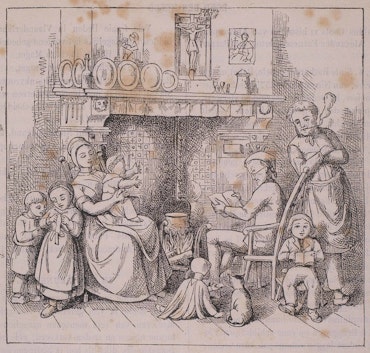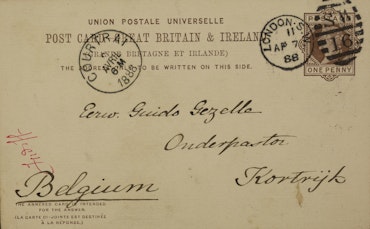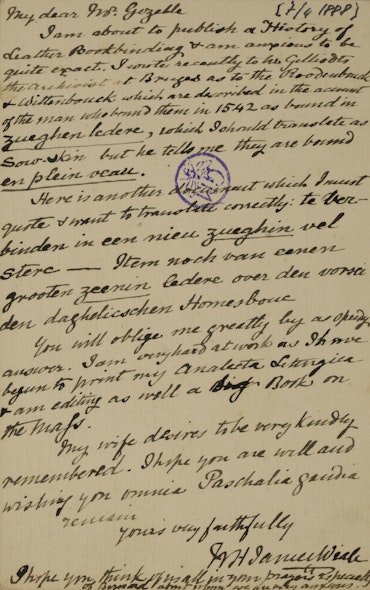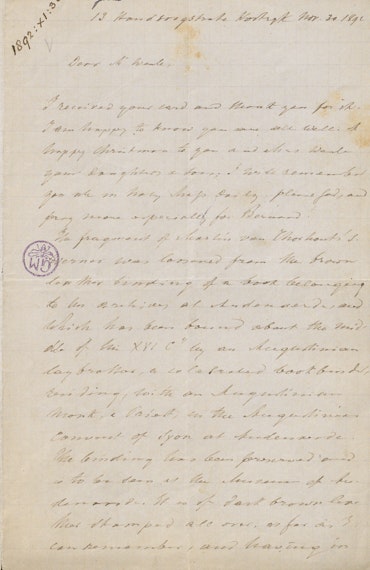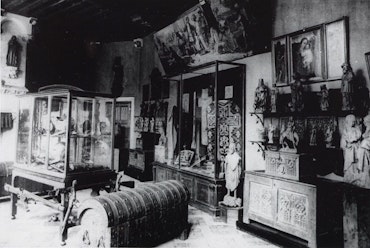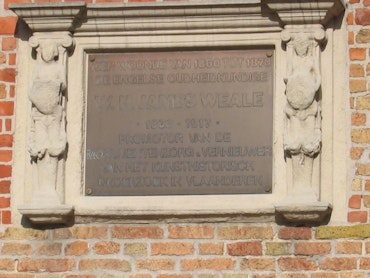
James Weale
St. Marylebone, London 08.03.1832 - Clapham, London 25.04.1917
William Henry James Weale studied Greek, Hebrew, history and theology at King’s College, London (1843-1848). He met Frederick Oakeley, chaplain of St. George’s in Southwark and on his instigation Weale converted to the Roman-Catholic church on February 9th, 1849. Oakeley became a priest at St. John, Islington and appealed to James Weale to establish a monastic community. Weale was then known as brother Francis Mary of the Angels.
He came to Bruges for the first time with a group of converts on the occasion of Monseigneur Malou’s consecration as a bishop. Later he travelled through Belgium. Next he was an office worker for a short while, and subsequently taught at a school for poor Irish children. He was sentenced to a three months' imprisonment for thrashing a pupil. He left on a long journey through Europe which kindled his interest in the Middle Ages and art.
He married Helena Amelia Walton on August 30th, 1854. They had 11 children. He arrived in Bruges in December 1854 and permanently settled there in 1857. He became acquainted with the Béthune brothers and the architects Brangwyn and King, important representatives of the christian art and building style in Flanders. Weale studied the art and liturgy of the Middle Ages. He discovered lost works of art and identified painters. He was a member of the Commission royale d’art et d’archéologie (Royal Commission on Art and Archeology) (1860) and corresponding member of the Koninklijke Commissie voor monumenten (Royal Commission for Monuments) (1861). In 1863 he created the Guild of St Thomas and St Luke in order to stimulate the study of ancient christian art. He was also the co-founder and first curator of the Société Archéologique (Archaeological Society). This society founded the first historical museum in Bruges, the precursor of the contemporary Gruuthusemuseum.
With Gezelle he started the magazine Rond den Heerd (By the Fireside) (1865) but stopped their cooperation on May 26th, 1866. He was then payed to write several articles and contributions.
In 1863 he began to work as a representative for the firm Chance Brothers Glass Works in Birmingham. He delivered glass to a.o. Jean Bethune and Samuel Coucke. In 1872 he was attached to the South Kensington Museum and charged with cataloguing Dutch objects of art. He left Bruges on August 3rd, 1878 and took up residence in Clapham, London. Among other things he imported liturgical books for the publishers Desclée de Brouwer (1883-1885).
He became the curator of the National Art Library in South Kensington but was forced to resign in 1897. In 1899 he organised an exhibition on the Flemish Primitives in the New Gallery in London, followed by a grand exhibition in Bruges in 1902. These are some of his important works: Guide book for Belgium, Aix-la-Chapelle and Cologne (1858), Bruges et ses environs (1862), Hans Memlinc (1865), Bibliographia Liturgica (1886), Analecta Liturgica (1889), Bookbindings in the National Art Gallery (1898), Hubert and John van Eyck (1908).
He came to Bruges for the first time with a group of converts on the occasion of Monseigneur Malou’s consecration as a bishop. Later he travelled through Belgium. Next he was an office worker for a short while, and subsequently taught at a school for poor Irish children. He was sentenced to a three months' imprisonment for thrashing a pupil. He left on a long journey through Europe which kindled his interest in the Middle Ages and art.
He married Helena Amelia Walton on August 30th, 1854. They had 11 children. He arrived in Bruges in December 1854 and permanently settled there in 1857. He became acquainted with the Béthune brothers and the architects Brangwyn and King, important representatives of the christian art and building style in Flanders. Weale studied the art and liturgy of the Middle Ages. He discovered lost works of art and identified painters. He was a member of the Commission royale d’art et d’archéologie (Royal Commission on Art and Archeology) (1860) and corresponding member of the Koninklijke Commissie voor monumenten (Royal Commission for Monuments) (1861). In 1863 he created the Guild of St Thomas and St Luke in order to stimulate the study of ancient christian art. He was also the co-founder and first curator of the Société Archéologique (Archaeological Society). This society founded the first historical museum in Bruges, the precursor of the contemporary Gruuthusemuseum.
With Gezelle he started the magazine Rond den Heerd (By the Fireside) (1865) but stopped their cooperation on May 26th, 1866. He was then payed to write several articles and contributions.
In 1863 he began to work as a representative for the firm Chance Brothers Glass Works in Birmingham. He delivered glass to a.o. Jean Bethune and Samuel Coucke. In 1872 he was attached to the South Kensington Museum and charged with cataloguing Dutch objects of art. He left Bruges on August 3rd, 1878 and took up residence in Clapham, London. Among other things he imported liturgical books for the publishers Desclée de Brouwer (1883-1885).
He became the curator of the National Art Library in South Kensington but was forced to resign in 1897. In 1899 he organised an exhibition on the Flemish Primitives in the New Gallery in London, followed by a grand exhibition in Bruges in 1902. These are some of his important works: Guide book for Belgium, Aix-la-Chapelle and Cologne (1858), Bruges et ses environs (1862), Hans Memlinc (1865), Bibliographia Liturgica (1886), Analecta Liturgica (1889), Bookbindings in the National Art Gallery (1898), Hubert and John van Eyck (1908).


